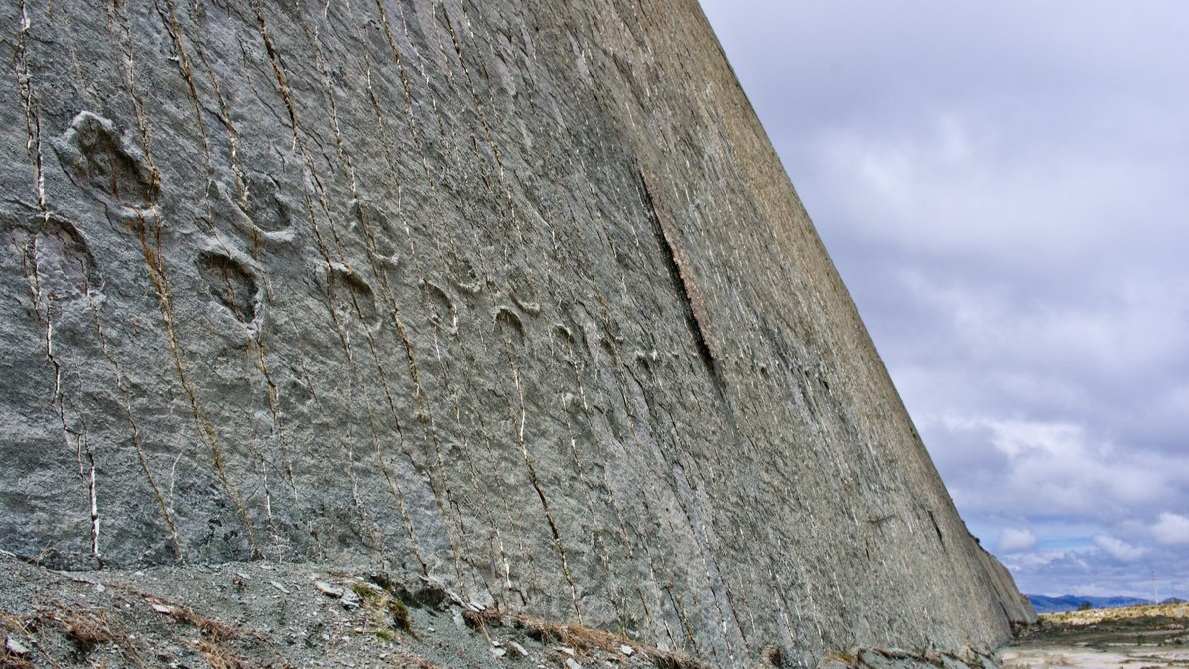Some ancient rock art depicts our ancestors’ purposeful leaving of handprints, providing a permanent mark of their existence. The startling prints discovered on a rock face in Bolivia were unintended marks created by naive painters.

Occasionally, a lucky series of events results in a perplexing phenomenon on Earth. One of these examples is the numerous dinosaur trails discovered embellishing what seems to be an almost vertical wall.
Footprints on the wall

Cal Orcko is a site in the Chuquisaca department in south-central Bolivia, near to Sucre, the country’s constitutional capital. The site is home to the Parque Cretácico (meaning “Cretaceous Park”), which is famous for having the world’s highest concentration of dinosaur footprints on a wall.
Finding a single dinosaur footprint millions of years old is exciting, but finding 1000s in one location is incredible. Archaeologists have characterized it as a “dinosaur dancefloor,” with layers of footprints forming a cross-hatched pattern of tracks.
Paleontologists were able to identify some of the several species of dinosaurs that formerly inhabited the region, feeding, fighting, and fleeing in an ultimately futile competition for existence thanks to these imprints.

Disturbing the dinosaurs
Cal Orcko means “lime hill” in the native Quechua language and refers to the kind of rock found at the location, which is limestone. This location is on the property of FANCESA, Bolivia’s national cement company.
This cement firm has been mining limestone for many decades, and it was its employees that found the first dinosaur footprints in 1985 at Cal Orcko. However, it wasn’t until nine years later, in 1994, that the massive dinosaur track wall was revealed by mining activity.

Despite the fact that paleontologists had begun to explore the dinosaur tracks, exposure to the environment and mining activities caused the wall to erode and crumble. As a result, the area was blocked for eight years so that something could be done to conserve this valuable wall. As a result, in 2006, the Parque Cretácico was opened to tourists.
A dinosaur wall of fame

The dinosaur track wall, which is approximately 80 m high and 1200 m long, is without a doubt the park’s main attraction. A total of 5055 dinosaur footprints have been discovered in this location. As a result, it has been claimed that this wall houses the world’s greatest collection of dinosaur footprints.
Paleontologists investigating the wall discovered that the footprints were separated into 462 individual tracks, allowing them to identify up to 15 different types of dinosaurs. These include ankylosaurs, Tyrannosaurus rex, ceratops, and titanosaurs, which all existed during the Cretaceous period, thus the park’s name.
How were the tracks laid?
It has been speculated that the Sucre area was once a large ocean inlet, and Cal Orcko a part of its shoreline. During the Cretaceous period, dinosaurs walked along this seashore, leaving their imprints in the soft clay, which were preserved when the clay solidified during dry times.
The previous layer of sediment would be covered up by a fresh layer of sediment, and the process would begin again. As a result, throughout time, many layers of dinosaur tracks were produced. This was demonstrated in 2010 when a portion of the wall fell. While this damaged some of the tracks, it also exposed an additional layer of footprints beneath it.
Formation of the wall

Based on the existence of freshwater species in the fossil data, it has been hypothesized that the ocean entrance eventually became an isolated freshwater lake.
Furthermore, as a result of tectonic plate movement throughout the Tertiary period, the road that the dinosaurs formerly traveled on was forced higher, becoming an almost vertical wall.
This is what resulted in the appearance of dinosaur tracks climbing the wall today. The cliff wall used to be freely accessible to the public, but in recent years, visitors could only catch a glimpse of it from a viewing platform within the park.
A new walkway, however, has been created that allows visitors to reach within a few meters of the wall, giving them much closer access to the dinosaur footprints.
An uncertain future

One of the primary worries about the dinosaur track wall is that it is a limestone cliff. Rock fragments that may occasionally separate and fall from the cliff might be considered a safety threat.
Worryingly, it is estimated that if the rails are not effectively safeguarded, they will be totally destroyed by erosion by 2020. As a result, the park is attempting to be designated as a UNESCO World Heritage Site, which would give it funding to carry out conservation efforts.



